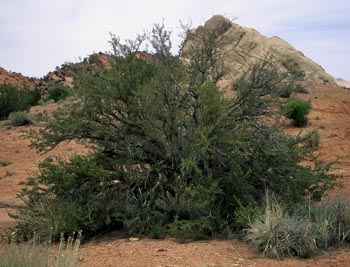Stansbury Cliffrose

Common Name(s):
Stansbury Cliffrose
Cliffrose
Scientific Name:
Purshia stansburiana (Torr.) Henrickson
Scientific Name Synonyms:
Cowania mexicana D. Don var. stansburiana (Torr.) Jepson
Purshia mexicana (D. Don) Welsh
Symbol:
PUST
Description:
Life Span: Perennial
Origin: Native
Season: Evergreen
Growth Characteristics: A 3 to 12 foot shrub or small tree, much branched, with a rounded crown. Flowers April to June and fruits mature September to October. Reproduces from seed, and rarely from sprouting.
Flowers/Inflorescence: Flowers are solitary and borne at the end of small lateral branches. The flowers are cream to yellow colored with 5 petals and 5 sepals.
Fruits/Seeds: Fruit is a hairy achene, with 4 to 10 seeds, topped with a 2-inch silvery, feathery tail.
Leaves: Alternate, often clustered at the tips of short branchlets, and very small (about ½ inch long). Divided into 3 to 9 (usually 5) lobes with rolled margins. The leaves are leathery, with shiny resinous glands, and are slightly hairy. The top of the leaf is dark green, and underside of leaf is a paler green with white hairs.
Stems: Twigs are erect and very bitter. Branches are brittle. The bark is green to reddish-brown when young, becoming black, scaly, and shreddy later. Wood is hard, heavy, and brown.
Ecological Adaptions:
Found on cliffs, hillsides, mesas, and in washes. It is usually found on the hot and dry south and west aspects, at elevations from 2,500 to 8,500 feet. It is drought resistant and mature plants are fairly shade tolerant.
Soils: Most abundant on rocky, limestone soils.
Associated Species: Utah juniper, pinyon pine, big sagebrush, gambel oak.
Uses and Management:
Stansbury cliffrose is an important browse species for mule deer, elk, pronghorn, desert bighorn sheep, livestock, game birds, and songbirds. Wild ungulates and livestock use it heavily in winter; it is the principle winter browse species on the Kaibab Plateau. Livestock may use it only lightly in spring and summer if deciduous browse species are available. Rodents eat Stansbury cliffrose seeds. Elk and other large ungulates use Stansbury cliffrose for bedding cover.
Triterpenoids extracted from Stansbury cliffrose have been shown to have inhibitory effects on HIV and Epstein-Barr virus. Native Americans used the inner bark for making clothing and ropes, and the branches for making arrows. Hopi used Stansbury cliffrose as an emetic and a wash for wounds.
Stansbury cliffrose is used in ornamental landscaping.

